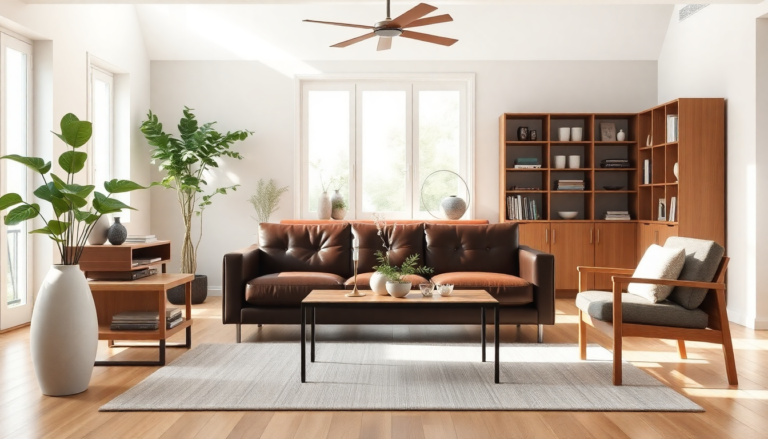Argomenti trattati
Decorating a home can feel like a beautiful puzzle, with each piece of furniture playing a crucial role in the overall picture. Yet, as anyone who has shopped for furniture knows, quality often comes at a steep price. But what does ‘quality’ really mean? Is it just about how much you’re willing to spend? In many cases, it relates to the craftsmanship and materials used. Investing in durable furniture is not just a financial decision; it’s a lifestyle choice that can influence how you live in your space for years to come.
Understanding furniture longevity
When it comes to furniture, longevity often hinges on the materials and the way the pieces are constructed. As Dan Campbell, president of BenchMade Modern, points out, “The better the materials and manufacturing processes, the longer the furniture will last.” So, if you’re contemplating whether to spend big on a well-crafted sofa or a solid wood cabinet for your guest room, it’s essential to consider how often each piece will be used. A sofa that endures daily family gatherings and movie nights requires different considerations than a cabinet that may see less action.
But here’s a thought: have you ever considered the impact of your home environment on the furniture’s lifespan? For instance, if you have kids or pets, or if your furniture lives in a high-traffic area, it will need to withstand more wear and tear. Understanding these dynamics allows you to make more informed choices that align with your lifestyle—because, let’s face it, not all furniture is created equal.
Sofas: comfort versus durability
Sofas are notoriously tricky. Campbell emphasizes the need to assess the frame, cushions, and upholstery carefully. He provocatively asks, “Who is using it, and where does it live?” The cushioning is often the first to show wear. So, when shopping, look for sofas that offer durability in their design. A blend of foam and fiber provides the resilience you need, while still allowing for a tailored look. However, comfort often trumps all for many shoppers. Dense foam might last longer, but it can also feel less cozy—there’s that age-old dilemma of comfort versus longevity! Personally, I recall investing in a sofa that was both comfy and sturdy, but boy, did it take some time to find that sweet spot.
To keep your sofa looking great, don’t forget to rotate and fluff the cushions every few months—think of it like giving your sofa a workout! Campbell likens it to rotating your car tires; equal wear is key to maintaining that fresh, inviting look we all crave.
Life expectancy of a sofa: approximately 10 years, if well cared for.
Bed frames that last a lifetime
Next up, let’s talk about bed frames. You essentially have two main choices: wood or upholstered. Wood frames can last indefinitely if they’re well-made, while upholstered options generally have a lifespan of 20-30 years. Campbell suggests that if you lean towards upholstery, you should choose fabrics wisely. A white linen headboard might sound chic, but it’s likely to show wear faster than a performance fabric that’s easy to clean—trust me, your future self will thank you!
Here’s a fun tidbit: I once had a friend who splurged on an upholstered bed frame, only to find it stained after just a few months. Now, that’s a lesson in fabric choice! So, if you want style and longevity, keep functionality in mind when making your selection.
The importance of dining chairs
Dining chairs are another piece where quality truly matters. The construction often outweighs the material. They endure constant movement, so they need to be robust. Campbell states that if you can splurge on one piece, let it be your dining chairs. For maximum durability, consider all-wood options, which are the easiest to maintain. If you prefer upholstered seats, make sure to opt for performance-grade fabrics that can handle spills and stains, because let’s face it—dinner time can get messy!
Life expectancy of dining chairs varies: all-wood can last indefinitely, while upholstered versions typically range from 10-20 years, depending on the grade of fabric.
Dining tables: stability is key
When it comes to dining tables, stability is crucial. As Campbell mentions, the materials and craftsmanship directly influence how long a table will last. A well-made wooden dining table can last a lifetime, while glass-top tables, which are often perceived as less durable, can also withstand the test of time if designed well. I remember dining at a friend’s house where they had a stunning glass-top table that was not only easy to clean but also a centerpiece of their dining area—definitely a conversation starter!
However, if you’re leaning towards wood, be prepared for some maintenance. Solid wood can crack or splinter over time, but it ages beautifully. If you prefer a rustic look, solid wood is a fantastic option, while medium-density fiberboard (MDF) with veneer can also provide stability for the long haul.
Life expectancy of a dining table: solid wood, immortal; glass-top, variable depending on design.
Dressers to stand the test of time
Lastly, let’s chat about dressers. The ones that last the longest tend to be crafted from solid wood—think cherry, oak, or maple. Campbell notes that while solid wood can have its issues with cracking or swelling, a well-constructed dresser can last forever. A veneer can also provide lasting durability, especially when crafted from high-quality materials.
Life expectancy of a solid wood dresser: immortal.
So, as you set out to furnish your space, remember that choosing investment-worthy pieces isn’t just about aesthetics—it’s about creating a home that reflects your lifestyle and stands the test of time. Investing in quality furniture can lead to a more fulfilling living experience, where each piece tells a story and serves as a part of your journey. After all, as the saying goes, “Good things come to those who wait”—and in this case, that means waiting for the perfect, durable furniture that brings you joy for years to come.

